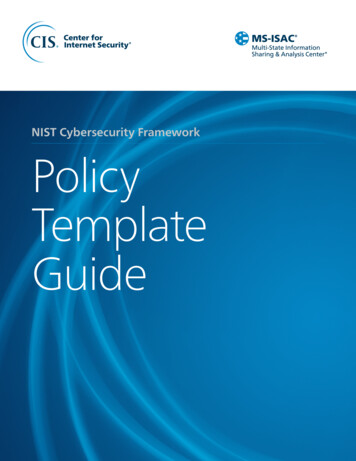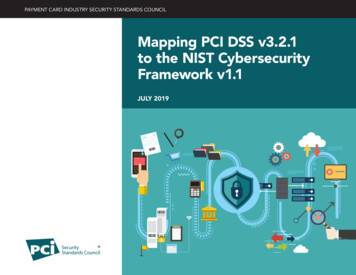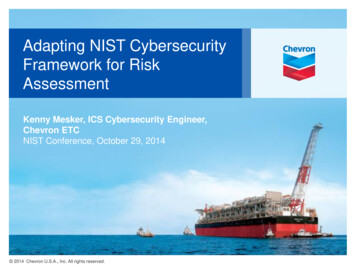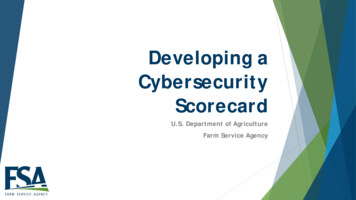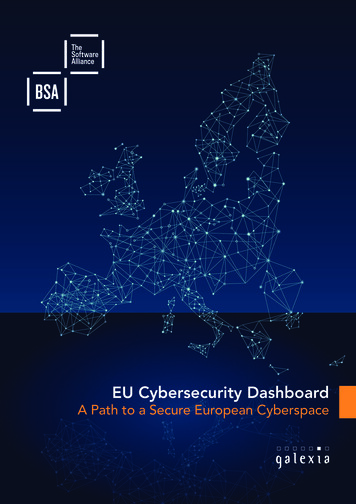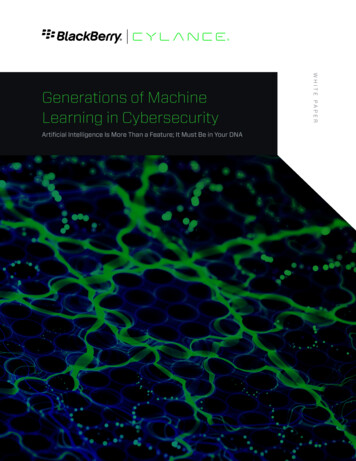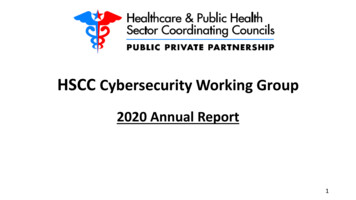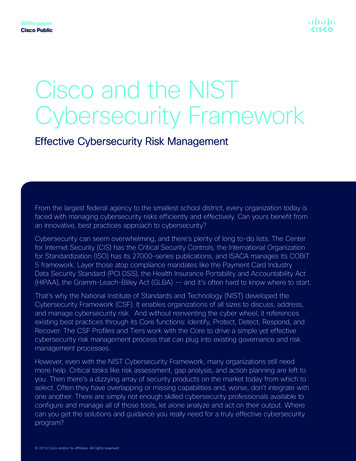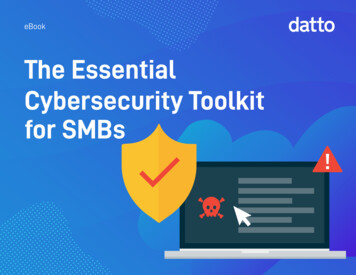
Transcription
eBookThe EssentialCybersecurity Toolkitfor SMBs1 datto.com
IntroductionCybersecurity: technologies, processes and practices designed to protect networks, computers,programs and data from attack, damage or unauthorized access.In a report from AT&T, 80% of businesses acknowledged they experienced some sort of a cyber attack.In 2018, these incidents have become even more common. For today’s companies, falling victim toone of these attacks is no longer a question of “if” but “when.” Today’s employees are connectedto the Internet all day every day, communicating with colleagues and stakeholders, sharing criticalinformation and jumping from site to site. With hackings, data breaches and ransomware attacks on therise, it is essential for all companies to plan for the worst, with mandatory cybersecurity trainings for allemployees and with the recommended solutions for mitigating the risks.Today’s data threats don’t discriminate; businesses of all sizes are susceptible to attacks. However,small to medium-sized businesses (SMBs) are often less prepared to deal with security threats thantheir larger counterparts. The reasons for this vary from business to business, but ultimately it comesdown to the fact that SMBs often have less resources to devote to cybersecurity efforts.This ebook contains practical advice and easy tips for training employees on cybersecurity and industrybest practices with real-world examples. We also outline the essential solutions designed to helptoday’s businesses defend against and recover from a cybersecurity incident. There has never been abetter time for this guide!2 datto.com
Cybersecurity Training for EmployeesAccording to over 1,700 IT service providers, the lack of cybersecurity awarenessamongst employees is a leading cause of a successful ransomware attack againstan SMB. That being said, employee training is a top component of a successfulcybersecurity protection program and most likely the only way to ensure all staffunderstand the cyber threats they face and, most importantly, what they should look forin order to avoid falling victim to them.Cyber Scams 101From 2016-2017, nearly one million U.S. businesses fell victim to ransomware, resultingin an estimated eleven million hours of downtime.At the root of the majority of ransomware attacks is the tactic of social engineering,leveraged by hackers, which involves manipulating a person or persons in order toAccording to over 1,700 ITservice providers, the lackof cybersecurity awarenessamongst employeesis a leading cause of asuccessful ransomwareattack against an SMB.access corporate systems and private information. Social engineering plays into humannature’s inclination to trust. For cyber criminals, it is the easiest method for obtainingaccess to a private corporate system. After all, why would they spend the time trying toguess someone’s password when they can simply ask for it themselves?Let’s help employees help themselves. Below is a quick and dirty overview of today’smost common and effective social engineering scams. This is the list to handemployees on their very first day. Why not include it in their “Welcome” packet? If theydon’t know these leading hacker tactics, they WILL fall for them.3 datto.com
5 Types of Social Engineering Scams to Know:Phishing: is the leading tactic leveraged by today’s ransomware hackers,typically delivered in the form of an email, chat, web ad or website designed toTakeaway: Employeeawareness of socialengineering is essentialfor ensuring corporatecybersecurity. If endusers know the maincharacteristics of theseattacks, it’s much morelikely they can avoid fallingfor them. As many of us arevisual learners, make sureto provide them with actualexamples of these scams.impersonate a real system and organization. Often crafted to deliver a sense ofurgency and importance, the message within these emails often appears to befrom the government or a major corporation and can include logos and branding.Baiting: similar to phishing, baiting involves offering something enticing to an enduser in exchange for private data. The “bait” comes in many forms, both digital,such as a music or movie download, and physical, such as a branded flash drivelabeled “Executive Salary Summary Q3 2016” that is left out on a desk for an enduser to find. Once the bait is taken, malicious software is delivered directly intothe victim’s computeQuid Pro Quo: similar to baiting, quid pro quo involves a request for the exchangeof private data but for a service. For example, an employee might receive a phonecall from the hacker posed as a technology expert offering free IT assistance inexchange for login credentials.Pretexting: is when a hacker creates a false sense of trust between themselvesand the end user by impersonating a co-worker or a figure of authority within thecompany in order to gain access to private data. For example, a hacker may sendan email or a chat message posing as the head of IT Support who needs privatedata in order to comply with a corporate audit (that isn’t real).4 datto.com
Tailgating: is when an unauthorized person physically follows an employee into arestricted corporate area or system. The most common example of this is when ahacker calls out to an employee to hold a door open for them as they’ve forgottentheir RFID card. Another example of tailgating is when a hacker asks an employee to“borrow” a private laptop for a few minutes, during which the criminal is able to quicklysteal data or install malicious software.How to Spot a Cyber ScamInbox ScamsThe above image is a prime example of a phishing email used to spread Locky, aImage 1common strain of ransomware. To the recipient, the email appears to come from abusiness partner asking the reader to “see the attached invoice” by clicking on theattached Word doc. Note how harmless this email appears and how easy it would befor a user to absentmindedly open and click, an action that would result in an instantransomware infection. It happens every single dayAbove is another example of an email scam, which appears to be an official noticefrom Amazon.com and lures the reader to click a link rather than an attachment, butwith the same business-crippling results.Image 2In image 3, note the link appears to direct the reader to a legitimate PayPal web pageand yet, when the mouse is hovered over the link, you see that it actually directs to adifferent site designed to inject malware or illegally collect personal information.5 datto.com
Red flags: Missing sender or recipient information, generic greetings, misspelledImage 3email addresses (i.e., billing@amzaon.com), and email addresses that don’tmatch the company name. Any emails that ask the recipient to download a formor macro in order to complete a task are highly suspicious and an employeeshould NOT click on anything. Instead, report the email to IT immediately.Malicious Websites and MalvertisingMalicious websites and malvertisements are designed to look like a page or adon a legitimate website. These sites can look incredibly real, featuring brandingand logos, which is why so many end up giving cyber criminals their personalinformation or access to directly inject malware onto their systems. Typically,hackers will insert code into a legitimate site which redirects unsuspecting usersto their malicious site. Above, you’ll find an example of a malicious page that wasdesigned to look like a page on Chase Bank’s site.6 datto.com
Pop UpsAnother common lure is a pop-up that claims that a user’s computer has been lockedby the FBI because it was used to access illegal material such as child pornography,as you will see in the example above. The lure instructs users to click a link in order topay a fine, which is bogus.Red flags: Links that redirect to a different domain, pop-ups that require you toenter personal information, misspelled URLs, and URLs with unusual domainextensions. This type of attack can be very hard to detect, even if employees areTakeaway: Be certain thatemployees understandthis risk and embrace safebrowsing habits, makingsure they are accessing sitesusing the HTTPS securecommunication protocol andbeing wary of any site askingfor private information. Also,show employees how to checkURLs that links point to (byhovering mouse over the linkto reveal the complete URL inthe status bar at the bottom ofthe browser).highly vigilant. This is why it is very important to deploy business-class malwaredetection software—which we will cover in detail in the next section of this ebook.Setting Up a Cybersecurity Training ProgramThe cybersecurity training schedule you choose, will be dictated by the specificnature of your business and the systems, software and hardware you leverage.However, a good start would be ensuring that all new employees receive trainingas part of their orientation and all employees receive training on a bi-annual basis.It is important to have a formalized plan in place to keep security front of mindand employees informed about new threats.While formal training is important, informal training can be very effective aswell. Point staffers to blogs on key security topics, ask them to take an onlinecybersecurity quiz, print out and post funny IT security memes around the office,etc. Do whatever it takes to keep people aware and following safe browsingpractices. If you don’t have resources to put this type of training together,talk with your IT service provider and see if they can assist with educationalmaterials or plans.7 datto.com
Essential Cybersecurity Solutions for SMBsHere’s one thing the cybersecurity world can agree on: there is no single productavailable today that will solve all of your cybersecurity problems. In today’sworld, it takes many technologies and processes to provide comprehensive riskand security management. Instead, SMBs should continually be checking theirsystems for vulnerabilities, learning about new threats, thinking like attackers andadjusting their defenses as needed.Must–Have Solutions for Cyber Protection: Layered SecurityAntivirus SoftwareTakeaway: Be certain thatemployees understandthis type of cyber scamis designed to prey uponhuman fear of breaking thelaw. Instruct employees whoencounter this type of popup NOT to click. Instead,they should restart thecomputer in safe mode.Still there? Get IT (or yourMSP) involved.Cybersecurity technology starts with antivirus software. Antivirus, as its nameimplies, is designed to detect, block, and remove viruses and malware. Modernantivirus software can protect against ransomware, keyloggers, backdoors, rootkits,trojan horses, worms, adware, and spyware. Some products are designed todetect other threats, such as malicious URLs, phishing attacks, social engineeringtechniques, identity theft, and distributed denial-of-service (DDoS) attacks.FirewallsA network firewall is also essential. Firewalls are designed to monitor incomingand outgoing network traffic based on a set of configurable rules—separatingyour secure internal network from the Internet, which is not considered secure.Firewalls are typically deployed as an appliance on your network and in manycases offer additional functionality, such as virtual private network (VPN) forremote workers.8 datto.com
Patch ManagementPatch management is an important consideration as well. Cyber criminalsdesign their attacks around vulnerabilities in popular software products such asMicrosoft Office or Adobe Flash Player. As vulnerabilities are exploited, softwarevendors issue updates to address them. As such, using outdated versions ofsoftware products can expose your business to security risks. There are a varietyof solutions available that can automate patch management.Password ManagementRecent studies have reported that weak passwords are at the heart of the rise incyber theft, causing 76% of data breaches. To mitigate this risk, businesses shouldadopt password management solutions for all employees. Many people have adocument that contains all of their password information in one easily accessiblefile—this is unsafe and unnecessary. There are many password management appsavailable today. These tools allow users keep track of all your passwords, and if anyof your accounts are compromised you can change all of your passwords quickly.Encryption is also an important consideration. Encrypting hard drives ensures thatdata will be completely inaccessible, for example if a laptop is stolen.These measures protect against a wide array of cyber attacks. However, becausethreats like ransomware are always evolving, security solutions are just one partof an effective defense strategy. You also need solutions in place that enable youto return to operations quickly if you do suffer a cyber attack. Data protectiontechnologies are an essential second layer of defense against cyber crime.9 datto.com
The #1 Solution for Cybersecurity Protection:Backup and RecoveryTaking frequent backups of all data considered critical to your business is critical.The exact frequency of backups will vary based on your business’ specific needs.Traditionally, most businesses took a daily backup, and for some businesses thismay still be suitable. However, today’s backup products are designed to makeincremental copies of data throughout the day to minimize data loss. When itcomes to protecting against cyber attacks, solutions that back up regularly allowyou to restore data to a point in time before the breach occurred without losing allof the data created since the previous night’s backup.Some data protection products can take image-based backups that are stored ina virtual machine format—essentially a snapshot of the data, applications, andoperating system. This allows users to run applications from the backup copy.This functionality is typically referred to as instant recovery or recovery-in-place.Datto’s version of this technology is called Instant Virtualization. The ability toru
techniques, identity theft, and distributed denial-of-service (DDoS) attacks. Firewalls A network firewall is also essential. Firewalls are designed to monitor incoming and outgoing network traffic based on a set of configurable rules—separating your secure internal network from the Internet, which is


